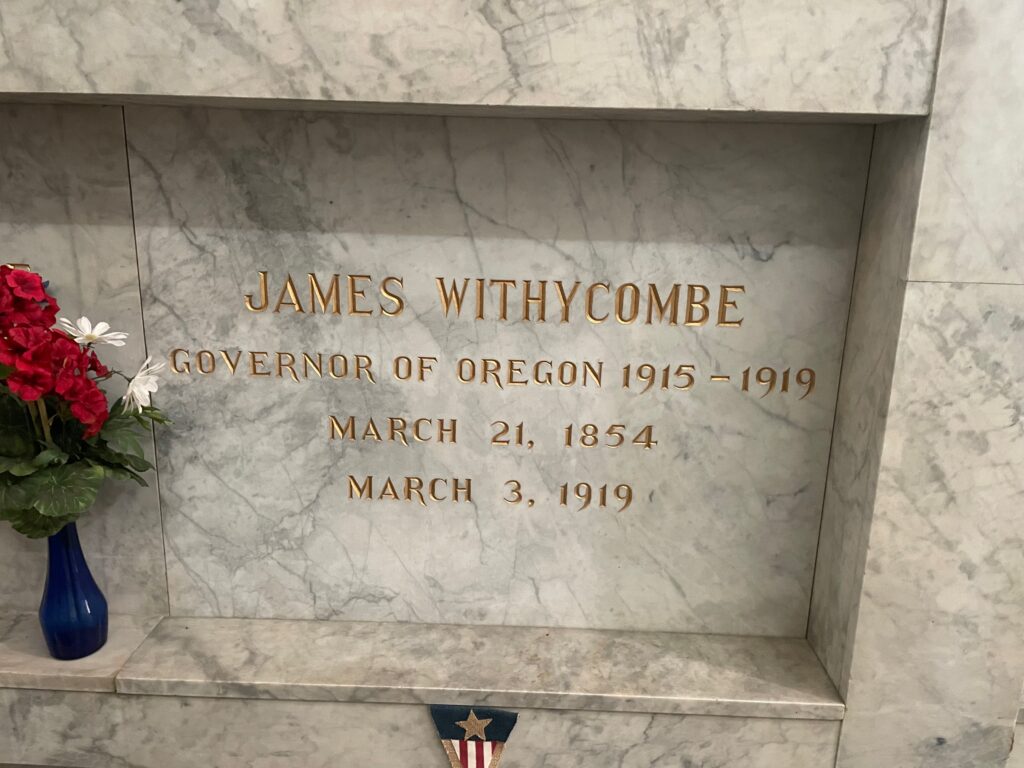Erik Visits an American Grave, Part 1,967
This is the grave of James Withycombe.

Born in 1854 in Tavistock, West Devon, England, Withycombe and his family migrated to Oregon in 1871, buying a farm near Hillsboro, which is today the Portland suburbs, but was rural back then. Though he was nearly grown, he worked his father’s farm for several years while saving up money to buy his own land. He would do this and become somewhat known for his livestock breeding techniques. He became involved in farmer organizations, including the Grange, and pushed for scientific, modern, efficient farming. He won a state position as State Veterinarian in 1889 (I wonder if that job still exists) and pushed for livestock health on a statewide level. Oregon State University (then Oregon Agricultural College) hired him to be the head of their experimental farming station. He was quite active in that role, pushing eastern Oregon farmers to grow alfalfa and clover, providing feed for cattle, which remains a big part of the agricultural economy there today, though not without a lot of irrigation, more than is useful.
All this exciting farmer leadership led him into the upper echelons of the state’s Republican Party. Oregon was generally a very conservative state in these years, though one with an active Progressive movement, largely based out of Portland, that pushed for social reforms and democratic accountability through ideas such as the reform, referendum, and initiative. So in 1906, he was nominated to be governor of the state by Republicans, someone who was pretty dang conservative, but who could speak the language of efficiency that Progressives liked. But he lost that election in a close match against George Chamberlain. But in 1914, Republicans tapped him again. See, in 1910, Oswald West, a Democrat, had become governor, and he really shook up the state, signing all kinds of bills that promoted democracy and reform, all while also being a massive eugenicist, as was extremely common for Progressives. But when West decided not to run for reelection, Democrats didn’t have an obvious choice and Withycombe ran on the banner of a newly energized Republican Party and won easily.
Early in his tenure as governor, Withycombe was pretty boring. Unsurprisingly, he promoted state investment in agriculture. He was a good roads movement guy too and pushed money to paving them. But once World War I started, Withycombe became a leader in crushing labor, which is what I know him for. He went all-in on patriotism in 1917 and if that included suspending the Constitution, well what did he care? Oregon was a hotbed of labor activism in these years, a bit less so than the rest of the Pacific Northwest, but enough. The Industrial Workers of the World had made major inroads in the timber camps due to the atrocious conditions workers had to labor under, in total isolation. In 1917, it had a successful strike, mostly based in western Montana, northern Idaho, and Washington, but certainly with some power in Oregon as well. In 1918, it threatened another strike over working conditions. Meanwhile, in Montana, radicals such as Frank Little were being assassinated by private security forces knowing the government supported their means of eliminating lefties.
So the western governors decided to work together to eliminate the radical threat in their state. They suspended basic free speech rights and threatened to arrest anyone opposing the war. Withycombe was all about this and suppression of free speech became his hallmark. Oregon would pass a law in 1919 around criminal syndicalism that basically made joining the IWW an illegal act. Of course the Wilson administration didn’t care, even if some might have thought the western states were a bit over the top in some of this. After all, this was the era of A. Mitchell Palmer in the Justice Department and his infamous Palmer Raids on radical organizations, deportation of radicals, etc. Withycombe called out the National Guard to crush a longshoremen strike in Astoria as well.
Withycombe ran for reelection in 1918 based on his love for America and hatred of radicals. The people of Oregon sent him back to Salem and it was about 10 points, so there wasn’t exactly a reaction to his own reaction. Oregon was a pretty reactionary state after all through the first half of the twentieth century. But then Withycombe had a heart attack and died in 1919, shortly after starting his second term. He was 64 years old.
James Withycombe is buried in Mount Crest Abbey Cemetery, Salem, Oregon.
If you would like this series to visit other World War I governors, and what a lovely lot of folks they are, you can donate to cover the required expenses here. Ernest Lister is in Tacoma, Washington and Samuel Vernon Stewart is in Helena, Montana. Previous posts in this series are archived here and here.


